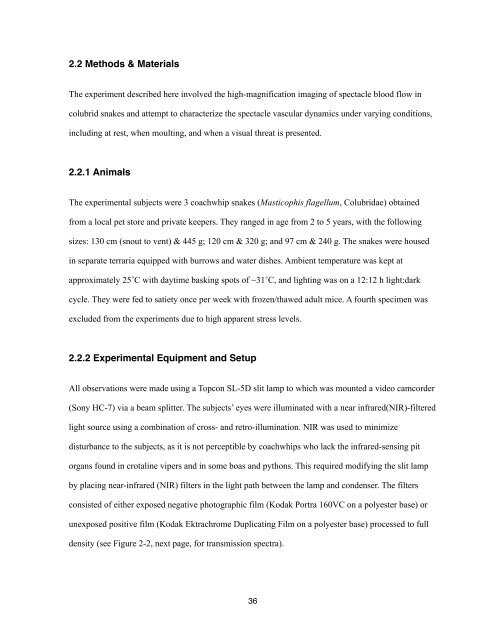Chapter 1, The Reptilian Spectacle - UWSpace - University of ...
Chapter 1, The Reptilian Spectacle - UWSpace - University of ...
Chapter 1, The Reptilian Spectacle - UWSpace - University of ...
You also want an ePaper? Increase the reach of your titles
YUMPU automatically turns print PDFs into web optimized ePapers that Google loves.
2.2 Methods & Materials<br />
<strong>The</strong> experiment described here involved the high-magnification imaging <strong>of</strong> spectacle blood flow in<br />
colubrid snakes and attempt to characterize the spectacle vascular dynamics under varying conditions,<br />
including at rest, when moulting, and when a visual threat is presented.<br />
2.2.1 Animals<br />
<strong>The</strong> experimental subjects were 3 coachwhip snakes (Masticophis flagellum, Colubridae) obtained<br />
from a local pet store and private keepers. <strong>The</strong>y ranged in age from 2 to 5 years, with the following<br />
sizes: 130 cm (snout to vent) & 445 g; 120 cm & 320 g; and 97 cm & 240 g. <strong>The</strong> snakes were housed<br />
in separate terraria equipped with burrows and water dishes. Ambient temperature was kept at<br />
approximately 25˚C with daytime basking spots <strong>of</strong> ~31˚C, and lighting was on a 12:12 h light:dark<br />
cycle. <strong>The</strong>y were fed to satiety once per week with frozen/thawed adult mice. A fourth specimen was<br />
excluded from the experiments due to high apparent stress levels.<br />
2.2.2 Experimental Equipment and Setup<br />
All observations were made using a Topcon SL-5D slit lamp to which was mounted a video camcorder<br />
(Sony HC-7) via a beam splitter. <strong>The</strong> subjects’ eyes were illuminated with a near infrared(NIR)-filtered<br />
light source using a combination <strong>of</strong> cross- and retro-illumination. NIR was used to minimize<br />
disturbance to the subjects, as it is not perceptible by coachwhips who lack the infrared-sensing pit<br />
organs found in crotaline vipers and in some boas and pythons. This required modifying the slit lamp<br />
by placing near-infrared (NIR) filters in the light path between the lamp and condenser. <strong>The</strong> filters<br />
consisted <strong>of</strong> either exposed negative photographic film (Kodak Portra 160VC on a polyester base) or<br />
unexposed positive film (Kodak Ektrachrome Duplicating Film on a polyester base) processed to full<br />
density (see Figure 2-2, next page, for transmission spectra).<br />
36
















